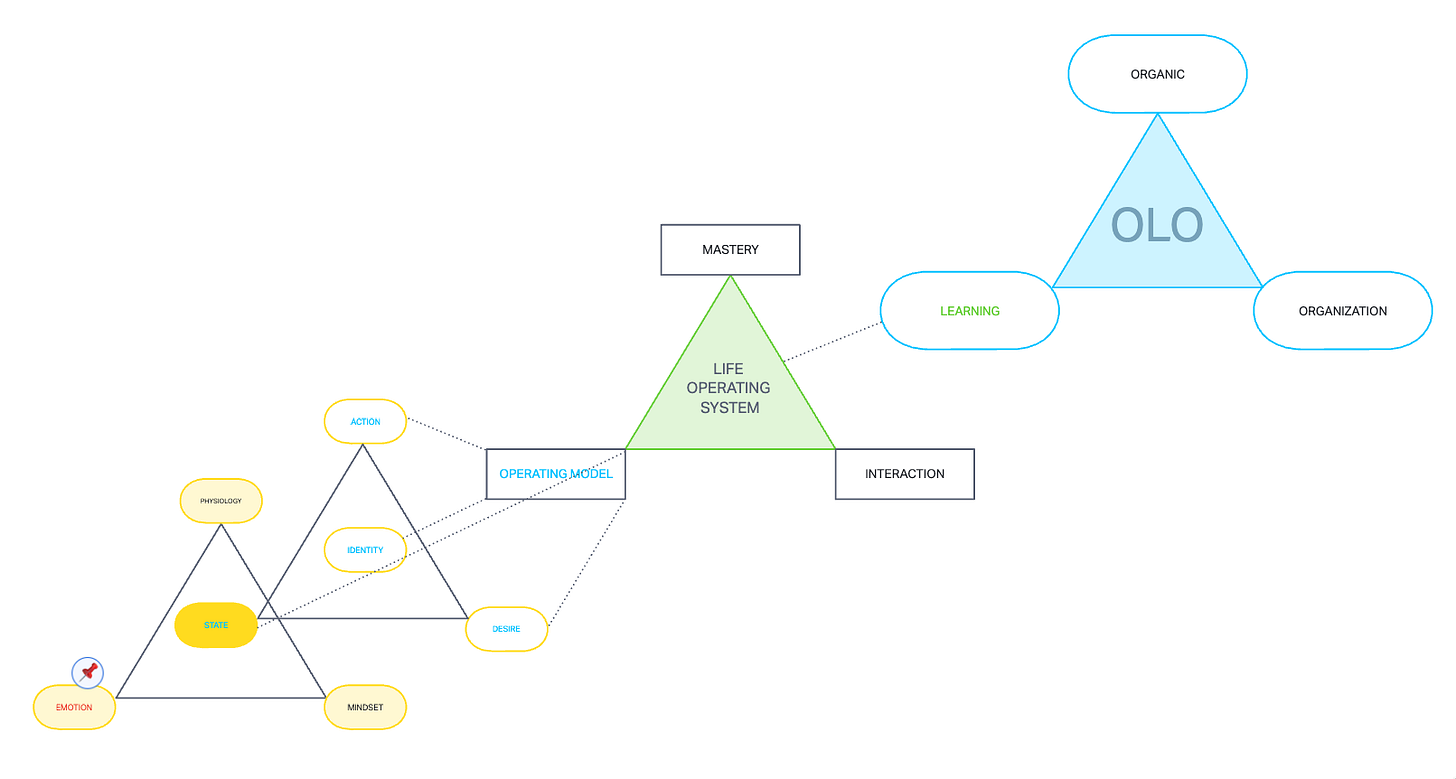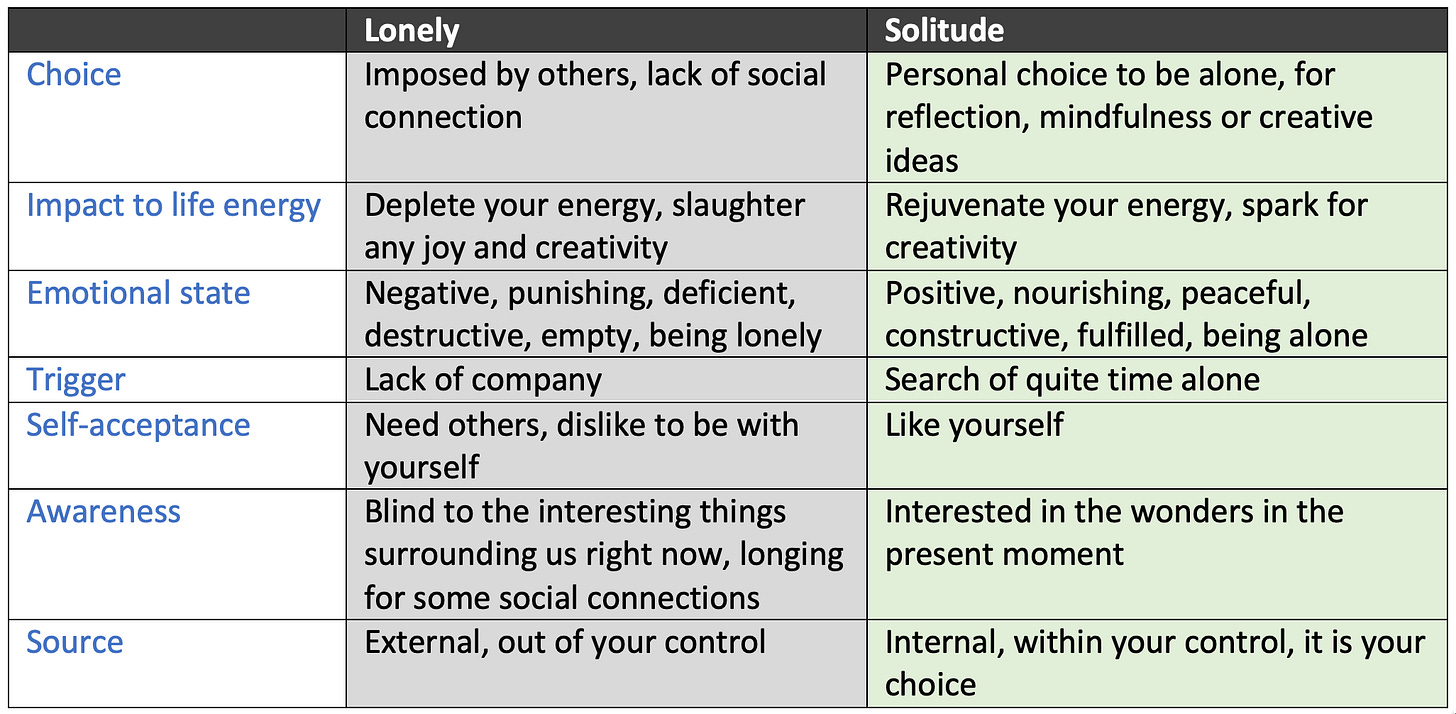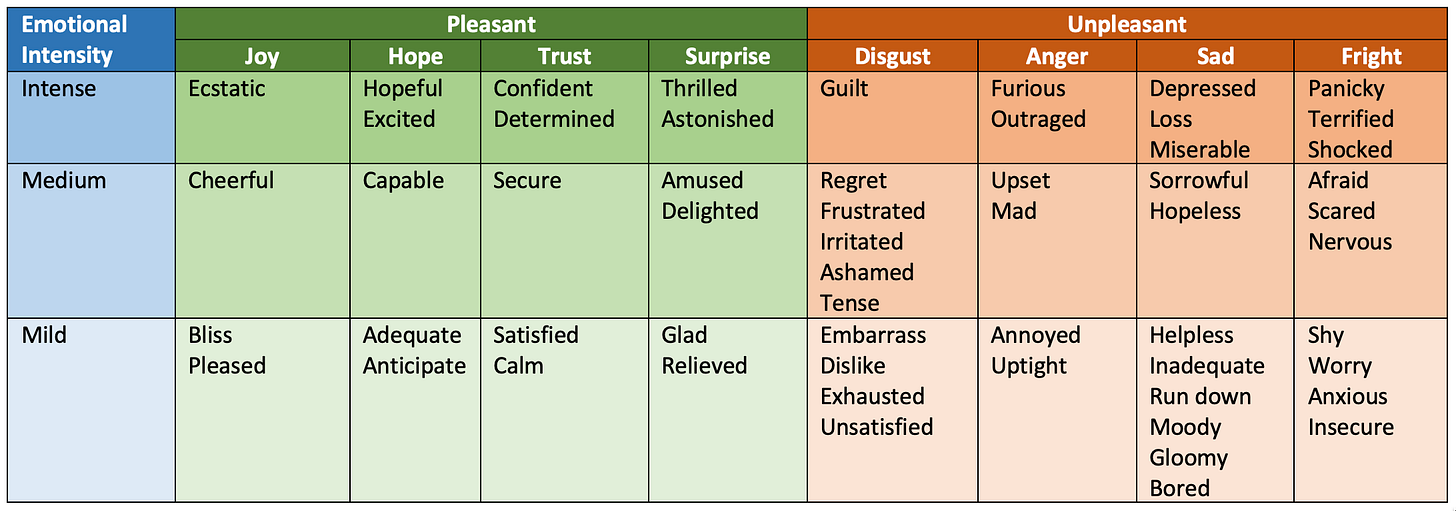I wrote about Amy and Danny (fictional lead characters in the Netflix drama series BEEF) on Bear Path Journal last week, how both of their road rage have a common fear of insecurity. I like to compile more notes related to emotions and feelings.
[image created by Bing Image Creator]
In the Organic Learning Organization (OLO) Life Operating System, ‘emotion’ is one of the 3 legs in the ‘state’ of being. In turn, ‘state’ is the vital life operating model (Identity - Action - State - Desire).
We can triangulate emotion, thought, and physiology to alter our state. We can change our posture to alter our state, emotions, and thoughts (mindset shift), which changes our physiology and feelings. By understanding how our mindset (thoughts, thinking), emotions (feelings), and physiology (movement, bodily reaction) influence and interconnect our state, we can change it to one that helps us.
The cells and microbiomes in our body play a vital role in our emotions. They are like citizens and foreigners staying on a planet but have no voice in the parliament. Only the mind can speak (think). However, almost all the primary metabolism, immunity, and maintenance of the body are managed by all these citizens, soldiers, and foreigners, except the politicians. Because they cannot speak with words, they communicate via chemical messages, and they scream with pain or pleasure sensation, letting the mind know their needs (drives). The mind interprets these signals and messages as ‘feelings’.
Emotions have deep connections with physiology, hence the term e-motion. Motion can also change the state and alter emotions. Or we can have the same physiological effect without the same emotion, e.g., heart racing after exercise or induced by fear. It is useful to know that the physiology of excitement is the same as anxiousness. When we feel anxious going on stage, we can tell ourselves, “I feel excited to be on stage.” It has the same physiology but a different meaning.
When we are alone, our state could be feeling ‘lonely’ or enjoying the ‘solitude’. These are very different states.
“Loneliness expresses the pain of being alone and solitude expresses the glory of being alone.” - Paul Tillich
Why do we have emotions?
Our cognitive systems are not fully developed as babies. So, emotion is the language through which our subconscious mind interacts with the real world. Emotions start with basic anxiety, fear, and needs (love). Needs activate anxiety, and the baby starts (experimenting) to cry, wave the limbs, smile, and try what works to get what we want. Hence, the encoding of emotions to our needs and the habitual response was developed in infancy.
As we grow into adolescents, our bodies escalate the hierarchy of needs from basic survival (food, shelter, safety) to social bonds. More complex social interactions (experiments) encode our emotions with neurotransmitters. Teens push the boundaries (they are more rebellious and like to be away from their primary caretakers), and most of our emotional encoding is formed by the time we reach our teenage years.
Soon, we develop the basic emotions, allowing our unconscious mind and body (nonverbal) to have a new communication language to coordinate with our body as a whole and interact with the world.
Emotions can be classified as two fundamental clusters of emotions: Love or Fear.
There are a few attributes of emotion:
Intensity (mild to intense)
pleasantness (painful to pleasurable)
Direction (moving towards or away from, inwards or outwards)
For example, anger can be slightly agitated, frustrated, annoyed, mad, furious, aggressive, and a broad spectrum of similar emotions as anger.
There are many classifications or charts of emotion available online. In most cultures, the words and labels used to describe emotions and feelings are overlapped or are used interchangeably. There is no universally agreeable definition for feelings.
Emotion does not define who we are. You are not a ‘bad person’ if you have a hot temper. By understanding the driver behind emotions, we can better interpret their meaning and take suitable actions.
Tony Robbins has another useful tip to interpret the unspoken message from a person’s response: the action always hints at either:
crying for help response
fun & loving response
Here are some examples of possible messages or meanings (subjective, may not work for everyone):
Tony often quotes the 6 human needs that motivate our behaviors:
Certainty (including survival)
Uncertainty (Variety)
Recognition (feeling important)
Loved (connected, belong)
Contribution
Growth
We also can look at the Maslow hierarchy of needs [image from Wikipedia] to find the interconnection between drivers (needs) and emotions.
What is the difference between Emotion and Feeling?
Emotion is the lower-level subconscious response, it is part of the ‘fasting thinking’ system, coordinated by sensory, primitive parts of our brain (e.g. Amygdala), using neurotransmitters to communicate with our guts (bacteria), organ cells etc. The primary objective is to keep us alive (survival) by punishing and rewarding us based on our interactions with external environments. For example, fight or flight reactions.
Feelings are like slower perceptions, meaning our conscious mind tries to make sense of emotions. Our conscious mind helps our long-term survival by encoding emotions with our experiences (beliefs and memories), such as depression.
Antonio D’Amasio, professor of neuroscience at The University of California and author of several books on the subject, explains it: “Feelings are mental experiences of body states, which arise as the brain interprets emotions, themselves physical states arising from the body’s responses to external stimuli. (The order of such events is: I am threatened, experience fear, and feel horror.).”
“Emotions play out in the theatre of the body. Feelings play out in the theatre of the mind.” - Dr. Sarah McKay, neuroscientist and author of the Your Brain Health blog.
Emotional Intelligence
Emotional Quotient, EQ, is a word popularized by Daniel Goleman in his book Emotional Intelligence. While IQ is often associated with success, EQ is the important intelligence for finding happiness. There are two parts to managing emotions.
Intrapersonal
Emotional self-awareness
Emotional self-regulation
Interpersonal
Empathy
Relationship
Tony Robbins has a 6-step approach to handling unpleasant emotions. It is worth learning:
What my feeling really was? (e.g. I felt hurt)
Use Transformation Vocabulary (TV) to soften the intensity (I feel a little bit down)
Get curious to explore the message behind this feeling. What is it trying to tell you (to change)?
Grateful and thankful for the feeling message.
Recall from the past experience that you recovered from similar feelings. Use that technique to change the state. Visualize (to cushion) if the same feeling arises. You know the right question to reframe it, change psychology, and change state.
Take action.
Suppose we can understand the possible meaning feelings and emotions convey from the subconscious mind or our traumatic response to our conscious mind. In that case, we can choose an empowering state by changing our physiology and mindset about the matter. This is the self-regulation step after we have improved our awareness and sensitivity to these subtle and mixed signals from our body.
It is my lifelong homework to practice these intrapersonal and interpersonal skills, including managing love and fear, stress, and empathy.
“Holding on to anger is like drinking poison and expecting the other person to die.” Buddha.
Weekly Update
Happy Mother’s Day. I am grateful that both my mother and mother-in-law are still around. I think the best day to celebrate Mother’s Day is our birthday, which is our mother’s suffering day.
I spent an hour watching the Hummingbird feeding its babies with nectar and tiny worm, “Happy Mother’s Day”.














